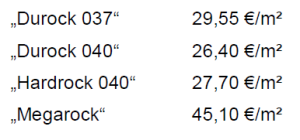 The AACHENER INSTITUT FÜR BAUSCHADENSFORSCHUNG UND ANGEWANDTE BAUPHYSIK published a report about warm flat roofs, insulated with mineral wool. The report describes a few cases, where humidity penetration into the mineral wool changed the properties of the mineral wool. I copied a few graphs from this public report into this post.
The AACHENER INSTITUT FÜR BAUSCHADENSFORSCHUNG UND ANGEWANDTE BAUPHYSIK published a report about warm flat roofs, insulated with mineral wool. The report describes a few cases, where humidity penetration into the mineral wool changed the properties of the mineral wool. I copied a few graphs from this public report into this post.
It is well known that humidity increases the thermal conductivity of the mineral wool in a distinct way from 0.040 W/mK up to 0.070 W/mK.
 But it is less known that this humidity also decreases the compressive strength of mineral wool, probably by damaging the binder.
But it is less known that this humidity also decreases the compressive strength of mineral wool, probably by damaging the binder.
 The report gives also 2011 prices for mineral wool with a higher compressive strength.
The report gives also 2011 prices for mineral wool with a higher compressive strength.
 These prices are not a surprise if we study the production of mineral wool. The production involves a melting at 1300°C before the fibers can be pulled and a binder can be added.
These prices are not a surprise if we study the production of mineral wool. The production involves a melting at 1300°C before the fibers can be pulled and a binder can be added.
GLAPOR cellular glass involves only foaming of waste glass up to 800°C without adding binders later on. The resulting cellular glass is absolutely water and vapour tight and has a much higher compressive strength (800kPa) with a higher thermal conductivity (0.055 W/mK). As a consequence, replacing 12cm mineral wool needs 16cm GLAPOR cellular glass, available at 32€/m² for larger quantities.
Given the absolute water and vapour tightness (and so a stable thermal conductivity and compressive strength) of GLAPOR cellular glass at a comparable price, cellular glass has to be considered in cases where a certain compressive strength is needed or a risk of water penetration is present.


Pingback: Heat pipe effect in wet permeable insulation? | BELGLAS BVBA
Your text was very good.
I am a student I can use your text?